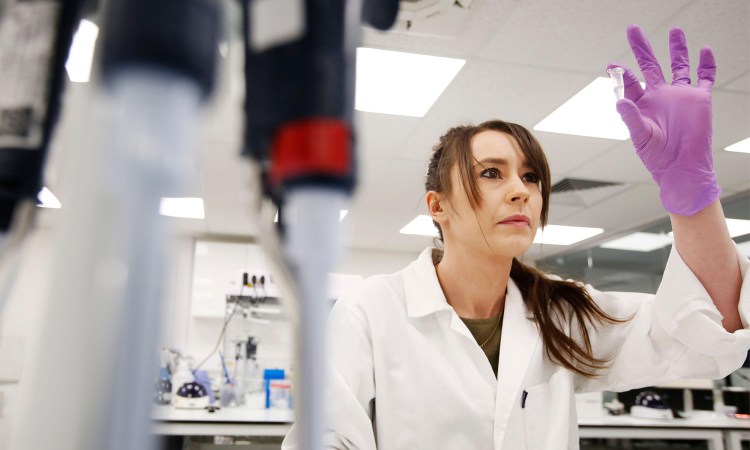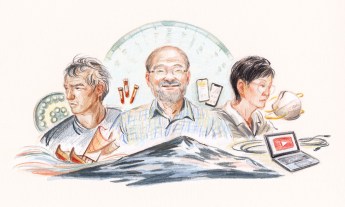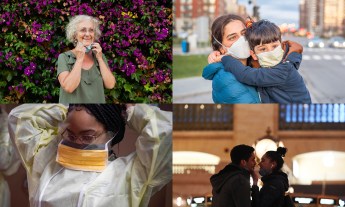
On March 11 2020, the World Health Organization (WHO) officially used the p-word — pandemic — to characterize COVD-19.
In the months since then, our world has changed in countless ways and countless people worldwide have scrambled to understand the disease — what causes it, how it spreads, what can be done to treat it, how can we make a vaccine that prevents it.
Among the scientists on its trail is Adam Kucharski. He is an associate professor at the London School of Hygiene and Tropical Medicine, a TED Fellow and author of the book The Rules of Contagion. Kucharski analyzes data and creates mathematical models to assess disease outbreaks and efforts to control them. His work contributes to the UK government’s Scientific Advisory Group for Emergencies — which provides research-based advice to policymakers — as well as to health agencies like the WHO.
Like many researchers, Kucharski expects that COVID-19 will disrupt our lives for at least the next year or two. “The pandemic won’t end properly until there’s enough immunity – ideally from a vaccine – to stop cases and hospitalizations rising again,” he says.
Below, Kucharski provides a research-based update on what scientists now know about COVID-19, as well as what they’re still trying to figure out:
Here are 5 things that scientists now know about COVID-19
1. The geographical source of the outbreaks was closer than assumed
Early in the pandemic, people in the US and Europe generally assumed that initial cases of the virus in their countries were directly imported from Asia. However, a preliminary analysis of the virus’s genetic data revealed this was a false assumption.
Since then, scientists have used the virus’s genetic signature to track how it moved from country to country, and when. As it turns out, the vast majority of early infections in the UK actually arrived from Italy and Spain back in February — and this was before outbreaks were even reported in those two countries. Italy reported its first local transmission on February 21, but by that point many infections had already made their way from there to the UK. Similarly, the epidemic in New York City likely started with infections that arrived from Europe in early February.
Unfortunately, because of the mistaken assumption about where the virus was coming from, health agencies focused early efforts on screening and quarantining travelers from Asia — and not also the people returning from their European holidays.
2. Airborne transmission is important
Early on, a lot of countries and people focused on cleaning surfaces and maintaining safe distances from people as prevention measures, resulting in an emphasis on hand washing, social distancing and disinfecting. While those are still important things to do, we now have data on how short-range aerosols in enclosed spaces like meeting rooms and gyms could easily transmit the disease.
By now, we’ve seen a number of case studies that show how enormously risky indoor group gatherings can be. For example, there was a case in Germany where someone without symptoms had an all-day meeting with 13 people, and 11 became infected. There was also a study in a hospital where researchers detected infectious virus in the air 7 to 17 feet away from patients.
Now that we know about airborne transmission, we have the ability to better fine-tune our personal risk assessments. If we’re considering going somewhere, we can ask: Is the event taking place indoors or out? What is the airflow like? Where and when are masks appropriate? Regarding masks, there’s evidence that they can help reduce transmission — which is counter to what some people thought earlier. However, we also know that masks alone weren’t enough to stop outbreaks in Hong Kong.
In general, there’s no one magic thing that will keep you completely safe. Earlier in the pandemic, public health messaging in many countries was very focused on the idea that as long as you were six feet away (or a couple of meters) from someone else, you were safe. Now we know we need to think beyond that overly simple dimension of risk — for example, staying six feet away from someone in a busy indoor gym is very different from keeping that distance from someone in a park.
3. It’s possible to stifle outbreaks without a full lockdown
An enforced stay-at-home policy is a blunt tool. What it essentially says is that leaders and officials aren’t confident about exactly what measures will work. But now we have longer-term data from countries — like South Korea and Hong Kong — that didn’t enforce full stay-at-home orders. There, people did wear masks in public and worked from home, and many venues like gyms, bars, restaurants and schools were closed for a time. While those were extensive measures and life looked very different than it did during pre-pandemic times, people still had some freedom to go out in public and meet up in small groups. This shows that a more refined approach — a combination of targeted measures, along with effective contact tracing and testing — can work to keep down transmission rates.
4. It’s hard to predict which countries will fare best in a pandemic
If you look at lists of pandemic preparedness rankings from a year ago, it’s very different from where we’ve ended up. In the 2019 Global Health Security Index, the US and UK were at numbers 1 and 2 in overall ranking. Meanwhile, as of this writing, those two countries are at number 1 and number 5, respectively, for total reported COVID-19 deaths. Few people would probably have predicted this situation.
I think it comes down in part to the nature of the virus — one that has rapid, hard-to-detect transmission — and in part to countries’ early responses. Countries’ outcomes have also been affected by how they structure their health systems and what they prioritize. Many countries — most notably, the US and the UK — have cut back their public health funding a great deal, and we’re seeing that hinder their capacity to counter the pandemic.
Of course, some countries that have experienced epidemics in recent decades have been able to put what they’ve learned into practice. Due to their previous responses to SARS and MERS, South Korea, Taiwan and Singapore already had legislation and capacity in place and responded more efficiently. By contrast, in the West, I detected an attitude among many politicians and journalists that COVID-19 was someone else’s problem. Globally, we need honest reflection about what constitutes preparedness in health systems.
A lot of how populations have responded is likely to be influenced by messaging from the top, which is crucial in outbreaks. You can’t expect people to change their behavior if they’re not aware of the risks, or if they don’t have confidence in the messaging. In epidemics, countries with both clear leadership and communication will tend to have more effective responses. Governments that don’t communicate well will risk reducing adherence and effectiveness.
5. When control measures are relaxed, outbreaks can quickly return
As case counts, hospitalizations and deaths declined in many countries in May and June, there was public speculation that the worst was all over. As a result, people relaxed their behaviors. But now researchers have seen very clear data from all over the world — from Australia and Israel to the US and Spain — that if people let their guard down and have too many risky interactions and gatherings, COVID-19 will come right back.
And here are 5 things that scientists still don’t know about COVID-19
1. Exactly how much do asymptomatic people contribute to transmission?
We know that people in younger age groups, especially schoolchildren, are less likely to develop COVID-19 symptoms. Unfortunately, this has made it difficult to understand the role that they play in driving outbreaks.
To do that kind of study, you need to identify infectious people and look at how they transmit. However, if those infectious people don’t show any symptoms, then you’re less likely to be able to spot them in the first place.
One of the additional challenges to gathering data is that schools were closed in much of the world for a time. Now that they’re open again, researchers are monitoring and testing students so they can work out what’s happening and how much transmission is occurring between students and teachers, family members and other close contacts.
2. Why are some people less susceptible than others?
It seems that some people are just less likely to get infected in the first place. Even though they’re exposed, the virus doesn’t take hold in them. We don’t yet know what’s influencing that. Could there be some pre-existing component of their immune response that’s fighting it off?
To study this properly, you need to track the particular immunological characteristics of a group of people that shows evidence of infection with COVID-19, as well as of another group that doesn’t. If there is a significant difference between the two groups, it could suggest that those characteristics might be associated with a sort of protection against infection and against symptoms. These studies are now getting underway, but it will take time for scientists to fully understand what drives — and what decreases — infection risk.
3. Why do some people get sicker than others?
We’ve seen a clear and dramatic increase in the severity of infection with age, but even within age groups, some seemingly healthy people get hit quite hard by COVID-19 while others don’t. What accounts for the inconsistencies?
Recent exposure to other related coronaviruses could potentially provide some cross-protective immunity, and there are other health factors that researchers are identifying — for example, there’s a higher risk of severe COVID-19 that’s been linked to heart disease and immunosuppression.
Based on other viruses, I think there could also be some genetic or biological factors. Some people may have genes that lead to increased risk of severe COVID disease, either directly or indirectly through another condition.
4. What control measures can countries sustain without significantly disrupting the lives of their citizens?
Different control measures have been tried around the world, and they all work — to one degree or another — by keeping infectious people away from at-risk people. New Zealand, for example, has tried to do it at the border level. After an initial lockdown, everyone within their country’s borders went back to behaving normally, but they faced stringent restrictions aimed to keep infection out of the country. Subsequent lockdowns in Auckland after small outbreaks have aimed to repeat this process.
By contrast, in countries like South Korea, measures have been aimed at the individual level. There, people who may be infected are tracked, tested and quarantined from the rest of the population. As a result, the latter then don’t have to live with stringent lockdown restrictions.
However, all control measures involve some amount of economic and social disruption. It looks like a safe, effective vaccine might not be available for a number of months, so the question is: What combination of control measures can countries actually sustain? And for what length of time?
In places like South Africa and India, lockdowns were lifted after around two months because they weren’t economically sustainable; people were going hungry. We may find places that are more isolated — like New Zealand — will find it easier to essentially shut their borders, while places that rely heavily on international trade and migration – such as South Asia or Europe – will find it much harder to do.
5. How long does immunity last after a person is infected?
As we’ve learned by now, there are many coronaviruses out there. Some of the seasonal coronaviruses cause respiratory illnesses like the common cold, and scientists know that this infection can confer some short-term immunity on people that eventually wanes, which means people can get reinfected, sometimes a year or so later.
That’s why we see seasonal coronaviruses circulate over time in populations, and for these, reinfections tend to result in less severe symptoms. So far, we’ve seen only rare reports of reinfections during this pandemic.
Populations that have had big outbreaks of this coronavirus — such as in parts of India or Latin America — have potentially built a degree of short-term immunity that could help suppress future outbreaks. But the question remains to be answered: How long will that protective effect last? This duration of immunity is important for vaccine development. Will we be able to get a vaccine once that will last us years, like the measles vaccine? Or will we have to get it annually, like a flu shot?
As we learn more, some things we believe about COVID today will be revised. Signals that looked promising might fade, while patterns will emerge from what we thought was noise.
As often as I can, I go back to the data to reflect honestly on how well we interpreted it. How did I evaluate the evidence at the time? Was I too cautious in my conclusions? Was I not cautious enough?
Some of our early analysis of transmission risk and disease severity has held up pretty well, but looking back I wonder if we could have gotten there sooner, or publicized the findings earlier. As the pandemic goes on, we scientists will all have to continue to hold ourselves to the process of regular, honest review.
Watch his TED Talk here:












